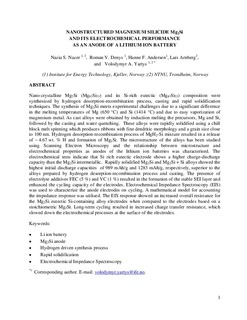Nanostructured magnesium silicide Mg2Si and its electrochemical performance as an anode of a lithium ion battery
Sainudeen Nazer, Nazia; Denys, Roman Volodymyrovich; Andersen, Hanne Flåten; Arnberg, Lars; Yartys, Volodymyr
Journal article
Submitted version
Permanent lenke
http://hdl.handle.net/11250/2478685Utgivelsesdato
2017Metadata
Vis full innførselSamlinger
- Institutt for materialteknologi [2544]
- Publikasjoner fra CRIStin - NTNU [37963]
Sammendrag
Nano-crystalline Mg2Si (Mg67Si33) and its Si-rich eutectic (Mg47Si53) composition were synthesized by hydrogen desorption-recombination process, casting and rapid solidification techniques. The synthesis of Mg2Si meets experimental challenges due to a significant difference in the melting temperatures of Mg (650 °C) and Si (1414 °C) and due to easy vaporization of magnesium metal. As cast alloys were obtained by induction melting the precursors, Mg and Si, followed by the casting and water quenching. These alloys were rapidly solidified using a chill block melt spinning which produces ribbons with fine dendritic morphology and a grain size close to 100 nm. Hydrogen desorption-recombination process of MgH2-Si mixture resulted in a release of ∼4.67 wt % H and formation of Mg2Si. The microstructure of the alloys has been studied using Scanning Electron Microscopy and the relationship between microstructure and electrochemical properties as anodes of the lithium ion batteries was characterised. The electrochemical tests indicate that Si rich eutectic electrode shows a higher charge-discharge capacity than the Mg2Si intermetallic. Rapidly solidified Mg2Si and Mg2Si + Si alloys showed the highest initial discharge capacities of 989 mAh/g and 1283 mAh/g, respectively, superior to the alloys prepared by hydrogen desorption-recombination process and casting. The presence of electrolyte additives FEC (5%) and VC (1%) resulted in the formation of the stable SEI layer and enhanced the cycling capacity of the electrodes. Electrochemical Impedance Spectroscopy (EIS) was used to characterize the anode electrodes on cycling. A mathematical model for accounting the impedance response was utilised. The EIS response showed an increased overall resistance for the Mg2Si eutectic Si-containing alloy electrodes when compared to the electrodes based on a stoichiometric Mg2Si. Long-term cycling resulted in increased charge transfer resistance, which slowed down the electrochemical processes at the surface of the electrodes.
